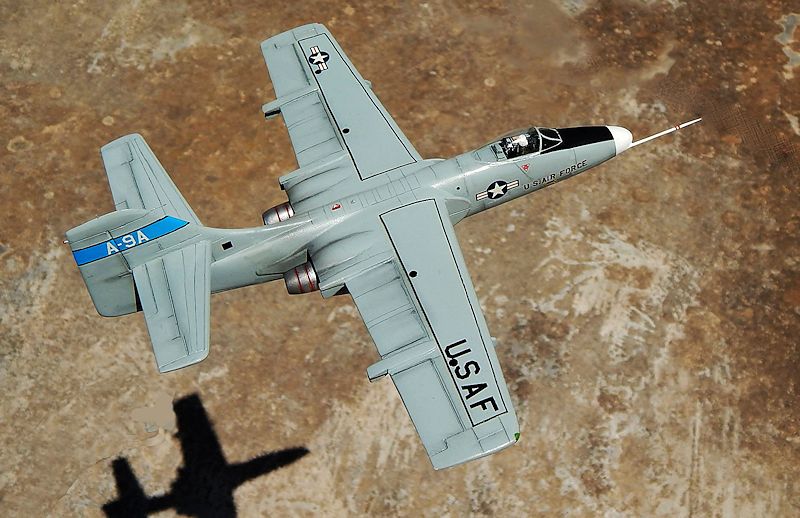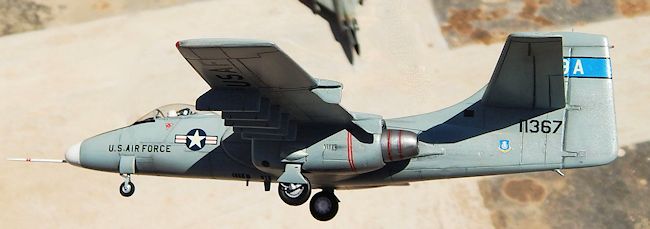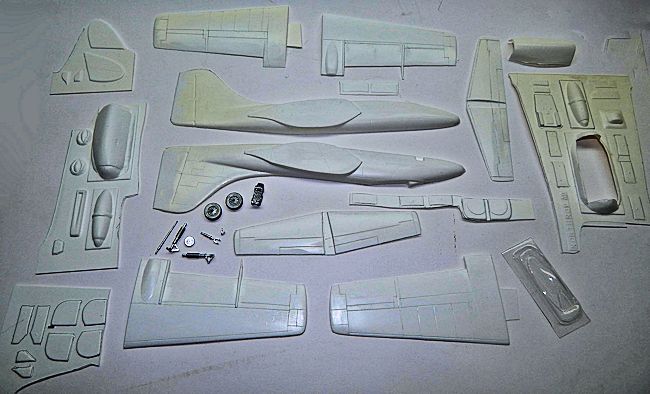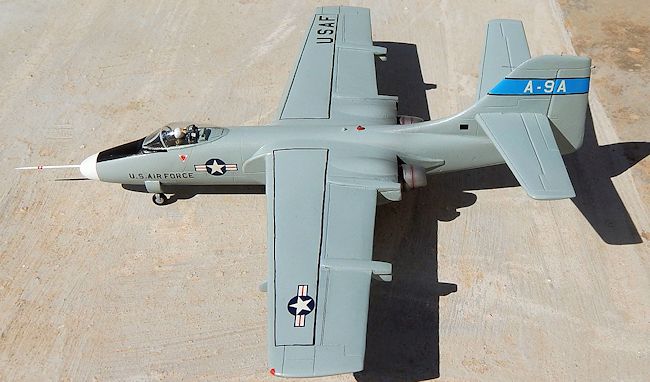
Project-X 1/72 Northrop YA-9A
| KIT #: | |
| PRICE: | £9.00 |
| DECALS: | One option |
| REVIEWER: | Carmel J. Attard |
| NOTES: | Vac-form kit complete with decals and white metal undercarriage, probe and pilot seat. |

| HISTORY |
 In task 1, four aircraft (two A-10s and two A9s) amassed some 300 hours of
manufacturer’s trials. The joint test force pilots also participated in their
earlier trials and were completely familiar with the aircraft types. L. Nelson,
the company’s flight test director, flew Northrop’s first A-9A on the 30th
May 1972 and 3 months later a second prototype joined the programme. The
fly-offs have been conducted on a comparable base with aircraft flying each
mission in pairs; one A-9 and one A-10; where assessment attributed to
temperature, wind and external factors being the same for both.
In task 1, four aircraft (two A-10s and two A9s) amassed some 300 hours of
manufacturer’s trials. The joint test force pilots also participated in their
earlier trials and were completely familiar with the aircraft types. L. Nelson,
the company’s flight test director, flew Northrop’s first A-9A on the 30th
May 1972 and 3 months later a second prototype joined the programme. The
fly-offs have been conducted on a comparable base with aircraft flying each
mission in pairs; one A-9 and one A-10; where assessment attributed to
temperature, wind and external factors being the same for both.
In Task 2 each aircraft type had to fly 50 hours on performance testing (which
included 6 hours devoted to Systems test), 53 hours on weapons delivery and 20
hours on a Tactical Air Command mission suitability test. The tests conducted
included carrying a large war load where special emphases were given upon
certain performance parameters equal for both types like serviceability, etc.
Other interesting comparison included a 2-hour loiter although not so great
distance from take-off, manoeuvrability in achieving a close support aircraft
and the USAF asked for an aircraft that could operate under 1,000 ft ceiling in
one mile visibility.
 Serviceability features were common to both the A-9 and the A-10 designs. Common
to both aircraft at the insistence of the air force were redundant control
actuation systems to provide back ups in the event of extensive damage, heavy
armour plating around cockpit and other vital areas, and self-sealing fuel tanks
fitted with surge baffles and plastic foam to minimize fuel loss in case the
tanks were holed by ground fire.
Serviceability features were common to both the A-9 and the A-10 designs. Common
to both aircraft at the insistence of the air force were redundant control
actuation systems to provide back ups in the event of extensive damage, heavy
armour plating around cockpit and other vital areas, and self-sealing fuel tanks
fitted with surge baffles and plastic foam to minimize fuel loss in case the
tanks were holed by ground fire.
Northrop A9 was a fairly conventional machine, the engines in fairings at the
wing root, with a single vertical stabilizer, five stores points on each wing
and landing gear that retracted completely. It was powered by a pair of Avco/Lycoming
ALF502 turbofans of 6,000 lb thrust each. Had a wingspan of 57 feet, a length of
53 feet 6 inches and a height of 17 feet 10 inches. The two prototypes were
assigned the serial numbers 71-1367 and 71-1368.
The winner of the production contract for the battlefield anti-tank aircraft was
the A-10A, which became known as the Thunderbolt II. Of the two
YA-9A
prototypes built 71-1367
is preserved
at the March AFB Museum.
| THE KIT |
 This is a vac form kit consisting of two white styrene sheets containing all the
kit components as fuselage halves, wing and tail plane parts, engine nacelles,
engine exhaust outlets, wheel doors, nose wheel well, enough parts to make 10
wing pylons and a clear acetate canopy. A small sealed bag contained the metal
parts comprising three metal legs and wheels, nose probe and an ejection seat.
1/72 scale side and front view and a scrap plan view all sufficient for
reference during construction of the kit are on one side of the instructions
while the opposite side has brief aircraft history, notes to assist in building
the model and kit parts exploded view.
This is a vac form kit consisting of two white styrene sheets containing all the
kit components as fuselage halves, wing and tail plane parts, engine nacelles,
engine exhaust outlets, wheel doors, nose wheel well, enough parts to make 10
wing pylons and a clear acetate canopy. A small sealed bag contained the metal
parts comprising three metal legs and wheels, nose probe and an ejection seat.
1/72 scale side and front view and a scrap plan view all sufficient for
reference during construction of the kit are on one side of the instructions
while the opposite side has brief aircraft history, notes to assist in building
the model and kit parts exploded view.
| CONSTRUCTION |
 Fuselage parts were first prepared, cutting area occupied by gun through on
starboard side of nose. On the prototype a long probe was fitted instead.
Cockpit bathtub was built from plastic card components as depicted in drawing
supplied. Side consoles and pilot instruments were carefully added to the fitted
inside the cockpit and a metal ejector seat added in place. Cockpit detail at
rear of seat was also added and the entire cockpit was painted medium grey while
the instruments and seat had touches of black. A crew figure was added to the
seat. The cockpit pre-assembly was then cemented onto one fuselage half. Plastic
tabs were added to the fuselage edge to serve as guides for the other half. The
offset nose wheel well was glued to the port fuselage half. A small compartment
to carry nose weight was also built in the nose area. A nose wheel leg hole was
drilled inside the nose well roof.
Fuselage parts were first prepared, cutting area occupied by gun through on
starboard side of nose. On the prototype a long probe was fitted instead.
Cockpit bathtub was built from plastic card components as depicted in drawing
supplied. Side consoles and pilot instruments were carefully added to the fitted
inside the cockpit and a metal ejector seat added in place. Cockpit detail at
rear of seat was also added and the entire cockpit was painted medium grey while
the instruments and seat had touches of black. A crew figure was added to the
seat. The cockpit pre-assembly was then cemented onto one fuselage half. Plastic
tabs were added to the fuselage edge to serve as guides for the other half. The
offset nose wheel well was glued to the port fuselage half. A small compartment
to carry nose weight was also built in the nose area. A nose wheel leg hole was
drilled inside the nose well roof.
Two splitter plates, flat on both sides were prepared and cemented into position
against fuselage sides, ensuring top surface aligned correctly before cementing
in place. Wings are cut, sanded and reinforced with cross pieces in between when
cementing wing parts together. Cutaways were cut at their root near leading
edge. These will accommodate the splitter plates already in place.
Engine bays were then cut and prepared, adding bulkheads within the bays to add
strength while the rear ones were to seat the engine outlet pipes. These
assemblies were cemented to the wing roots and the fuselage and again making a
cutaway in lower surface to accommodate the splitter plates. An item missing
 rom the kit was the front of rotor blades central bullet shaped fairing. This
was visible from the outside and had to be scratch built.
rom the kit was the front of rotor blades central bullet shaped fairing. This
was visible from the outside and had to be scratch built.
Upper and lower jet exhausts were prepared and cemented centrally into rear
engine bay attaching to rear bulkhead. Close study to photos ‘on line’ indicated
how far these protruded on the outside. The upper and lower tail plane halves
were cemented together and attached to fin. I made a cardboard template to
equalize the correct dihedral angle on both sides using the front elevation view
depicted on the instructions. The flap guides, four in number, were prepared
fresh, as ones given were slightly undersize. These were attached to inner wing
fairings. Even the fairings themselves were enlarged, as the ones integrated
with the wing trailing edge were undersize and too short. Undercarriage legs
added in place and wheel doors glued in place. Cockpit canopy was trimmed with a
sharp knife, checked for correct seating and fixed in place using white glue.
The metal nose probe was too small and was replaced with a metal one of correct
size. This was fitted to starboard side. 10 bomb racks were finally fixed at
equally spaced stations under wings. Through out the construction all panel
lines were refreshed with scoring tool as these were lightly marked.
| COLORS & MARKINGS |
Wheel wells were light gray, the rest of aircraft was airbrushed in ADC gray FS36473 using Model Master brand. Tail fin band was sky blue and not gray as indicated. Decals issued were of good quality and applied in normal fashion. Systems command crest was attached to rear port side. This came from Micro Scale decal sheet which indicating crew from that command involved in the evaluation programme. This was in fact carried on the aircraft during later stage.
| CONCLUSIONS |
 Instructions indicate that this kit is for expert modelers however this kit was
not different from other vac form kits and anyone with some experience could go
for. My opinion is that I’d rather go for a vac form kit than a resin one that
costs ten times as much and with risk of having the solid parts slightly
deformed with our kind of hot weather. All in all it took me just over a week to
complete this project and every stage of it went smooth. It will now join the
A-10 and other ADC type models. As one can see this hobby of ours bring back
past issues in aircraft designs and research projects, which will go unnoticed
and be forgotten for good let alone recognizing the capacity and energy of all
the men involved throughout the evaluation programme with every new aircraft
design.
Instructions indicate that this kit is for expert modelers however this kit was
not different from other vac form kits and anyone with some experience could go
for. My opinion is that I’d rather go for a vac form kit than a resin one that
costs ten times as much and with risk of having the solid parts slightly
deformed with our kind of hot weather. All in all it took me just over a week to
complete this project and every stage of it went smooth. It will now join the
A-10 and other ADC type models. As one can see this hobby of ours bring back
past issues in aircraft designs and research projects, which will go unnoticed
and be forgotten for good let alone recognizing the capacity and energy of all
the men involved throughout the evaluation programme with every new aircraft
design.
June 2015
If you would like your product reviewed fairly and fairly quickly, please contact the editor or see other details in the Note to Contributors.